Reviews
by Michael Frye | Nov 21, 2012 | Announcements, Reviews
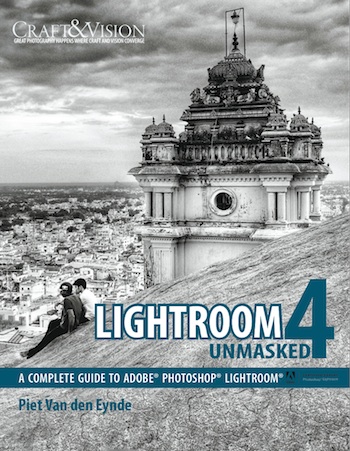 Even if you know a program well it helps to have a comprehensive guide, a book that covers everything from A-Z, so you can look up a keyboard shortcut, remember how to do that thing that you only do once a year, or learn some new tricks.
Even if you know a program well it helps to have a comprehensive guide, a book that covers everything from A-Z, so you can look up a keyboard shortcut, remember how to do that thing that you only do once a year, or learn some new tricks.
My favorite Lightroom bible has been Martin Evening’s The Adobe Photoshop Lightroom 4 Book. I still think that’s a great resource, but I might have a new favorite: Piet Van den Eynde’s new ebook called Lightroom 4 Unmasked.
This is a truly comprehensive guide to Lightroom 4, from setting up and importing, to organizing in the Library Module, processing images, mapping them, exporting them or publishing them to Flickr or Facebook, and printing.
If you’re new to Lightroom there’s a lot of great information here to help you get started. For example, the Lightroom Do’s and Don’ts (page 20) offers some invaluable advice to help you make the most of the program and avoid some common pitfalls.
Even if you know Lightroom well you’ll undoubtedly discover some new tips. One that I’m anxious to try is on page 238 — using Lightroom’s Publish Services to automatically put images on my iPhone and iPad. Cool — I didn’t know you could do that.
This is another ebook by Craft & Vision, the publisher of my two previous ebooks. But this one is different. Craft & Vision is calling this a “big book,” and it is that: a full 312 spreads. Because this is roughly four times the size of their typical ebooks, the price for Lightroom 4 Unmasked is higher than normal — $20. But until midnight on Tuesday, November 27th you can get it for only $15. Just use the code LR4FIVE on checkout.
(more…)
by Michael Frye | Dec 7, 2011 | Announcements, Reviews
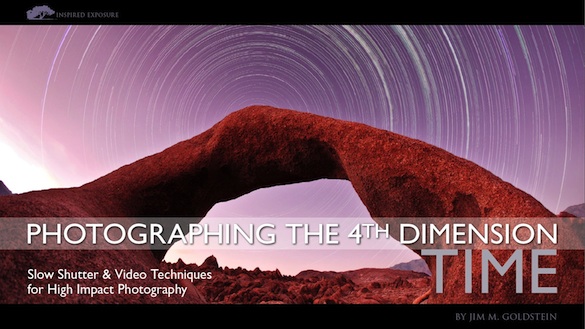
Jim Goldstein has just released a new eBook called Photographing the 4th Dimension – Time. In the book Jim describes seven different slow shutter speed and video techniques for making more creative photographs—including long exposures, light-painting, star trails, time-lapse, and cinemagraphs.
This book is a great way to delve into some new, fun, and creative aspects of photography. If you’ve never tried photographing star trails, making time-lapse videos, or creating cinemagraphs, Jim makes it easy to get started by giving you step-by-step instructions, sometimes including video tutorials.
Just browsing through the book can inspire you to try some new techniques and give your photography a creative kick in the pants. Personally I was intrigued by the cinemagraphs, where part of a still photograph is animated. Some cinemagraphs I’d seen before looked rather cheesy, but after viewing some of the examples here I realize that they can be done subtly, and beautifully, so I’m eager to try them—and it’s nice to have Jim’s detailed instructions for doing so.
(more…)
by Michael Frye | Sep 22, 2011 | Reviews
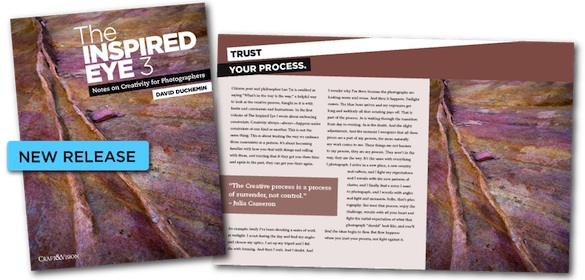
David duChemin has just released another eBook, The Inspired Eye III. If you read my review of his previous eBook, A Deeper Frame, you know that I’m a fan of David’s writing. He looks at photography in a deeper way than most, and is able to articulate sometimes-complex ideas clearly.
This latest eBook, the third part of his Inspired Eye series, is no exception. It contains lots of interesting thoughts and insights into the creative process of photography. I was particularly struck by this passage:
“You can learn about photography by reading books, watching videos, and listening to other photographers. You can study hundreds of photographs. But you will not learn your own process of making photographs until you have a camera in your hands and you make photograph after photograph.”
As I mentioned in my last post, I went to the Millpond Music Festival last weekend, and in his workshop on Sunday Joe Craven said something similar—that we learn by imitating, and by doing, not by studying theory. I think he’s right on the mark about that, and so is David in saying that you have to make lots of photographs to “learn your own process.”
(more…)
by Michael Frye | Aug 19, 2011 | Reviews
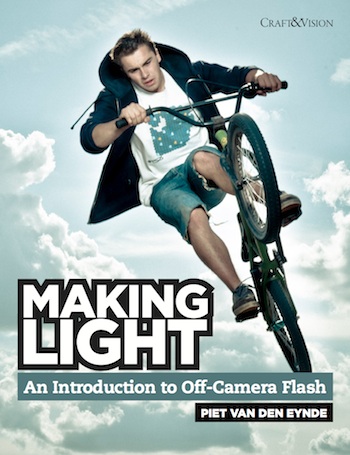 Light is a vital aspect of photography—maybe the single most important element. We often assume that we have to adapt our photography to whatever light is available, but that’s not always true. We can create our own light.
Light is a vital aspect of photography—maybe the single most important element. We often assume that we have to adapt our photography to whatever light is available, but that’s not always true. We can create our own light.
Flash is one of the most effective ways of doing that, but flash technique and equipment can be complicated and intimidating. I’d been a serious photographer for a long time before I ever used flash. In fact I was assisting Moose Peterson with a workshop in Montana in the early ’90s, and as he tried to attach a flash to my camera he said, “This is a virgin hotshoe!” It was true: no flash had ever been mounted on that camera. Moose shook his head in amazement, and then loaned me an old flash of his that he didn’t use any more, encouraging me to experiment with it.
I guess I took that advice and ran with it, eventually using flash in highly complex ways to make some of my best-known nighttime images. But even if you have no desire to take things this far, learning to use flash can add an extra dimension to your photography. It’s especially effective with people, but can also be used in many interesting ways for landscapes.
Maybe I’ll write a post about using flash for landscapes sometime, but in the mean time Craft & Vision has just released a new eBook called Making Light, by Piet Van Den Eynde, and I think it’s a great introduction to general flash technique, and especially for using flash with people. Piet (pronounced Pete) does an excellent job of making the sometimes complex world of flash photography easy to understand. He encourages you to take the flash off the camera (absolutely essential in my opinion), and shows you exactly how to do that. I especially liked his examples—nine in all—showing how he used minimal equipment to add light to his photographs of people. Piet likes to travel by bicycle, so that forces him to keep his equipment simple!
As always, this Craft & Vision eBook is only five dollars. What’s more, until midnight, August 21st, you can get Making Light for $4 (discount code LIGHT4). Or you can buy five eBooks for the price of four (discount code LIGHT20). That includes my eBook Light & Land: Landscapes in the Digital Darkroom, so if you don’t already own a copy this is a great opportunity to get both Light & Land, Making Light, and three other Craft & Vision eBooks for only $20. (I’ve reviewed two more of these eBooks in the past: A Deeper Frame by David duChemin, and The Evocative Image by Andrew S. Gibson.)
—Michael Frye
Michael Frye is a professional photographer specializing in landscapes and nature. He is the author and photographer of The Photographer’s Guide to Yosemite, Yosemite Meditations, and Digital Landscape Photography: In the Footsteps of Ansel Adams and the Great Masters, plus the eBook Light & Land: Landscapes in the Digital Darkroom. He has written numerous magazine articles on the art and technique of photography, and his images have been published in over thirty countries around the world. Michael has lived either in or near Yosemite National Park since 1983, currently residing just outside the park in Mariposa, California.
by Michael Frye | Jun 29, 2011 | Reviews
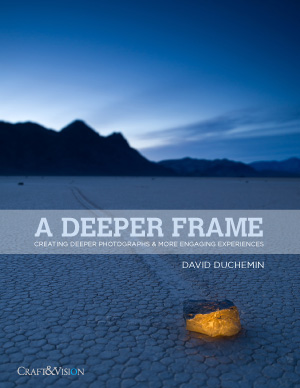
A Deeper Frame
I think David duChemin is one of the most refreshing voices in the world of photography today. While most of the photographic world seems to talk about equipment, or the latest way to make your photographs “pop” in Photoshop, David prefers to talk about vision, and emotion, and the art of photography. Radical stuff.
David, as some of you may know, is the founder of Craft & Vision, the publisher of my eBook Light & Land: Landscapes in the Digital Darkroom—as well as over twenty other eBooks. It’s been awhile since David wrote his own eBook, so I was excited to hear that he was working on a new one.
This book—A Deeper Frame—is now available, and it lives up to my high expectations for David’s writing. In this volume David examines an aspect of photography that most of us have probably thought about at one time or another: depth. But in typical fashion, David offers fresh perspectives, and (pardon the pun), a deeper look at this vital subject. He certainly got me thinking with passages like this:
The more a photograph recreates the illusion of reality as we experience it, the deeper the potential experience, the longer the memory of the image, the greater the possible impact on their hearts and minds. Deeper photographs give us a means to create more engaging one-frame visual stories.
Of course there’s also plenty of more practical advice about how to create depth in your photographs, including an interesting discussion of perspective, placement of elements within the frame, optics, and focus. Then he moves on to some less-obvious ways to create depth through color and light.
If there’s one thing missing from this volume, it’s how to flip this concept around: to deliberately flatten the perspective in a photograph—something I do frequently. Maybe I’ll post something about that here in the future. But in the meantime, I highly recommend you read this eBook. If nothing else it will get you thinking about the whole concept of depth in photographs, something that most of us—myself included—pay too little attention to.
As always, this Craft & Vision eBook is only five dollars. What’s more, until midnight, July 2nd, you can get A Deeper Frame for $4 (discount code DEEP4). Or you can buy 5 eBooks (including Light & Land, if you don’t already own a copy!) for the price of 4 (discount code DEEP20). And, for the first time, an even bigger volume discount: 12 eBooks for $40. Use discount code DEEPER12.
by Michael Frye | Mar 21, 2011 | Reviews

When I think about contemporary landscape photographers who’s work I admire and respect, Guy Tal is definitely on that list. He consistently produces beautiful work in a natural style that reflects his appreciation for the natural world.
I recently had the opportunity to review Guy’s eBook, Creative Landscape Photography. I’ve read a lot of books and articles about photography, and written a few myself, so it’s refreshing when I find something that presents a new idea, or a new way of looking at the process of photography. This book does that. Guy has the ability to get you to think in different ways about photography, and about your own approach to a subject. Rather than presenting recipes for successful photographs, or abstract philosophical ideas, he gives you concrete steps to help provoke your own thought process, and stimulate your creativity.
This includes a list of questions to ask yourself before photographing a subject, like, “What element(s) do I find most visually appealing about the scene?, or “What emotion(s) can I convey to my viewers using the elements in this scene?” All vital questions.. While highly-experienced photographers may consider such things instinctively and automatically, even they can use a reminder, and less experienced photographers will find that a conscious effort to answer these questions will pay big dividends.
Guy has always struck me as a thoughtful person, and that comes through in this volume. It’s clear that he’s has given a lot of thought to every aspect of landscape photography:
“A common enemy of good composition is the impulse when an attractive scene presents itself to immediately reach for the camera, snap a few quick exposures, and move on to continue the hunt. In reality, chances are your perspective will not be ideal at the precise moment you discover your subject.”
“Consider all the rules, take what works. Apply where appropriate, but do not be afraid to break every last one of them. Go with your instinct. Photograph for yourself and satisfy your own sensibilities and aesthetics. True artists do not pander to a pre-selected audience. Instead, they carve an audience of their own from those who will encounter and be moved by their work.”
The heart of the book is the first four sections, called The Creative Process, Concept, Visualization, and Composition. The remaining three parts—Capture, Processing, and Presentation—support the ideas presented in the beginning, explaining how to carry your original vision through to a finished photograph. The book also includes many of Guy’s beautiful photographs to inspire you, most from one of my favorite regions in the country, the canyons of southern Utah.
Anyone who’s serious about making better, more creative landscape photographs will learn a lot from this eBook. It’s available directly from Guy Tal’s web site for 9.95. He’s also announced a sequel,Creative Processing Techniques in Nature Photography, due out later this year.
 Even if you know a program well it helps to have a comprehensive guide, a book that covers everything from A-Z, so you can look up a keyboard shortcut, remember how to do that thing that you only do once a year, or learn some new tricks.
Even if you know a program well it helps to have a comprehensive guide, a book that covers everything from A-Z, so you can look up a keyboard shortcut, remember how to do that thing that you only do once a year, or learn some new tricks.












